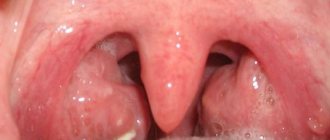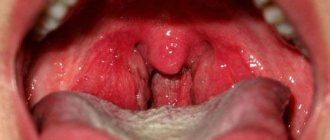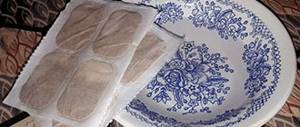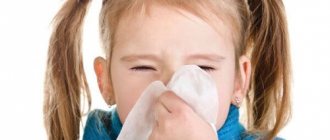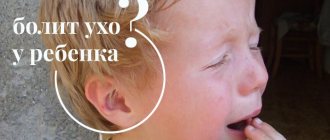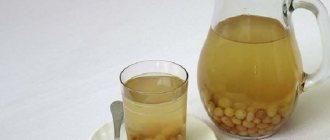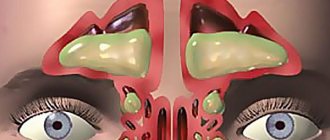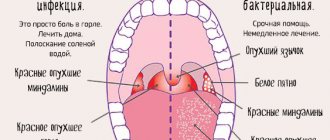Rhinitis (runny nose) is the main symptom of colds and various viral infections.
In addition, a runny nose is the body’s protective reaction to irritation by various microbes, viruses and allergens of the mucous membrane. Protection of the mucous membrane manifests itself in the form of increased secretion of mucus, sneezing and swelling, which remove pathogens at the initial stage of penetration into the body.
Rhinitis is part of a group of diseases called sinusitis. This group, in addition to rhinitis, also includes: sinusitis, ethmoiditis, frontal sinusitis, sphenoiditis. For a visual example, consider the picture below:
Types and causes of rhinitis (runny nose)
- Vasomotor rhinitis. This type of runny nose is caused by impaired nasal breathing due to narrowing of the nasal cavity, which is a consequence of swelling of the tissues of the nasal turbinates, due to impaired vascular tone of the nasal mucosa. Vasomotor rhinitis is divided into:
- Allergic rhinitis. Reasons: the body's reaction to house dust, poplar fluff, animal hair, fluff, feathers, plant pollen.
— Neurovegetative rhinitis . Causes: violations of the nervous mechanisms responsible for the normal physiology of the nose.
- Infectious rhinitis. This type of runny nose is the most common. Its main causes are viruses and bacteria. In addition, any type of infectious runny nose is a companion to diseases such as ARVI, influenza, measles, scarlet fever, diphtheria, etc. It is dangerous because the virus, penetrating the nasopharynx, disrupts the body’s defense mechanisms and allows free entry for the virus. Infectious runny nose is divided into:
- Acute rhinitis; — Viral rhinitis; - Bacterial rhinitis.
- Chronic rhinitis. Divided into:
- atrophic rhinitis. Causes: A complex chronic type of runny nose, the causes of which are hereditary predisposition, viral infections and long-term diseases of the nasal cavity. This type of runny nose is called “Stinking runny nose of Ozen”.
- hypertrophic rhinitis . Causes: Occurs upon contact with dust and gases. Due to these factors, the bone frame of the nasal concha and mucous membrane grows.
- Drug-induced rhinitis. The cause of drug-induced runny nose, as a rule, is addiction and abuse of various drops and sprays.
- Traumatic rhinitis. Caused by damage to the nasal septum.
Why does vasomotor rhinitis occur?
The nasal mucosa is rich in blood vessels. There are areas in it that contain special cavernous tissue - dilated veins. Under the influence of high and low temperatures, chemicals, strong odors, mechanical irritation, and stress, the cavernous tissue quickly fills with blood. The vessels dilate, the mucous membrane swells. This leads to nasal congestion and mucus production.
With vasomotor rhinitis, this mechanism begins to work incorrectly. It would seem that nothing special is happening, there are no strong irritants, but the person develops a runny nose. The causes of the disorder are not fully known. Scientists and doctors only know about triggers - “triggers” that provoke a reaction from the mucous membrane:
- Any irritants in the air. A person suffering from vasomotor rhinitis may feel worse when he inhales the smell of perfume, is in smoky, dusty conditions, near substances that emit strong odors, if someone smokes nearby.
- Respiratory infections.
- Dry air.
- Some medications: ibuprofen, acetylsalicylic acid, oral contraceptives, antidepressants, some drugs for the treatment of arterial hypertension. If you use vasoconstrictor drops for a runny nose often and for a long time, they also provoke rhinitis.
- Spicy or hot food, drinks.
- Hormonal changes in a woman’s body during menstruation and pregnancy.
- Frequent stress.
- Thyroid hormone deficiency (hypothyroidism).
Main causes of runny nose
To summarize everything, we can identify the following main causes of runny nose (rhinitis):
- hypothermia of the body; — heavy dust and gas contamination of the air; — viruses, bacteria and other pathogens; - colds and other diseases associated with the nasopharynx; - improper use of medications; - hereditary predisposition.
Classification of the common cold according to the pathogen
Types of rhinitis according to their causative agent are classified into:
- viral;
- bacterial;
- allergic;
- medicinal.
Most often, a viral runny nose occurs - the causative agents of the infection are mainly rhinoviruses, coronaviruses, influenza viruses A and B. Viral types of runny nose in children, as a rule, are caused by adenoviruses. This type of disease is accompanied by colorless watery discharge, increased body temperature and general fatigue. Swallowing mucus from the nose can cause coughing, especially in children.
A bacterial runny nose often occurs in combination with rhinitis of viral origin - bacteria take advantage of the weakening of the nasal mucosa due to exposure to viruses and attack it. Secondary rhinitis of bacterial etiology occurs. Their symptoms consist primarily of a change in watery discharge to a yellow-green, thick mucus that may have a slight odor.
Bacterial inflammation of the nasal cavity often spreads to the sinuses, resulting in a nasal voice and ear congestion (this occurs due to a blockage of the eustachian tube, which equalizes pressure in the middle ear). Due to blockage of the cavities, severe pressure and pain may be felt in the forehead and cheeks.
These types of runny nose are not a disaster - therapy, as a rule, lasts no longer than 1 week and consists of bed rest, drinking enough fluids and using recommended medications (to relieve nasal congestion, it is good to use nasal drops and drink hot drinks, especially herbal teas) .
If necessary, treatment involves additional reduction of high fever with medications containing paracetamol, and is supplemented by taking essential vitamins, especially vitamin C.
Drug-induced rhinitis occurs as a result of improper use of certain medications. The most common cause is so-called nasal decongestants, which are effective in relieving nasal congestion. However, with long-term use, these medications cause damage to the nasal mucosa. According to the duration, acute and chronic runny nose is distinguished.
Symptoms of rhinitis (runny nose)
- Symptoms of allergic rhinitis:
- nasal congestion; - runny nose like water; - itching and movement in the nose; - redness of the eyes.
Forms of allergic rhinitis: - seasonal; - year-round; - professional.
You can find out what exactly you are allergic to in the hospital, therefore, it is better to consult a specialist, since allergic rhinitis, if not treated correctly, can lead to bronchial asthma.
- Symptoms of neurovegetative runny nose:
Read also Abscess - symptoms, causes and treatment of abscess
- labored breathing; - thin watery discharge; - frequent attacks of heavy liquid discharge after sleep.
Treatment of this type of runny nose should include treatment of the nervous system, sedatives and water procedures.
- Symptoms of acute runny nose:
- frequent sneezing; - lacrimation; - general malaise; - copious serous-mucous discharge, acquiring a mucopurulent character.
- Symptoms of a viral runny nose
- dryness and burning in the nose; - swelling of the nasal turbinates; - difficulty breathing through the nose; - sneezing; - increase in body temperature (after some time).
If you experience these symptoms, it is best to consult a doctor.
- Symptoms of bacterial rhinitis:
- increase in body temperature; - headache; - swelling of the nasal turbinates; - cloudy, thick discharge of yellow or green color; - redness above the upper lip and near the nose.
Prolonged bacterial runny nose can lead to inflammation of all sinuses (sinusitis), otitis media and other more serious diseases.
- Symptoms of atrophic rhinitis:
- atrophy of the mucous membranes and bone walls of the nasal cavity; - discharge of purulent secretion with a sharp, unpleasant odor; - dried crusts; - loss of smell.
If you have this type of runny nose, it is better to consult a doctor immediately.
- Symptoms of hypertrophic rhinitis:
- constant difficulty in nasal breathing.
It is treated by removing hypertrophied areas of bone and mucous membrane.
- Symptoms of drug-induced runny nose:
- mucosal vessels stop working independently.
This is a difficult type of runny nose to treat, since the nutrition of the mucous membrane is disrupted and it dies.
- Symptoms of traumatic rhinitis:
— often, one half of the nose suffers from rhinitis, and the other from dry mucous membrane; - no snot comes out. They thicken and flow down the wall of the larynx into the pharynx.
In this case, it is necessary to lower the temperature and increase the humidity in the room where people are most often present. This can be done, for example, using a humidifier.
Symptoms
With all allergic diseases and, in particular, with hay runny nose, we only get the deceptive impression that we are dealing with a purely local disease. Therefore, shock organs or shock tissues are only of relative importance, but in fact the whole organism reacts. Upon contact with a specific substance, all sensitized cells begin to react and everything depends on the place where the specific substance hits first and, moreover, in sufficient concentration to cause a reaction. Therefore, symptoms prevail, sometimes from the respiratory tract, sometimes from the digestive tract, sometimes from the skin.
With hay fever, the nasal mucosa is not the only shock organ.
If we leave aside the symptoms of the nose, then with hay runny nose the following phenomena are also observed: in the oral cavity and pharynx - hyperemia and swelling; in the bronchi - swelling of the mucous membrane and secretion with coughing; on the skin - rash of urticaria; on the conjunctiva of the eyes - swelling and hyperemia; from the vascular system - increased heart rate and decreased blood pressure; from the blood side - hemoclasic shock. Nasal symptoms during hay fever are a kind of barrier device that prevents the unhindered absorption of the bloom. Nasal discharge and sneezing expel pollen that has collected there from the nasal cavity, nasal congestion prevents further pollen from entering the nose, and swelling of the mucous membrane reduces the possibility of pollen absorption. Local symptoms of hay fever are as follows: repeated sneezing, watery secretion, and nasal congestion. In addition, lacrimation, decreased sense of smell, headaches and pressure in the head, asthma and various nervous symptoms are usually observed.
Hay runny nose manifests itself in individual attacks of the symptoms described above, which are extremely painful for patients. Symptoms from the nose are also accompanied by laryngitis, tracheobronchitis with the release of purulent sputum during a painful cough, and even asthma.
In addition to purely nasal symptoms, intestinal phenomena in the form of colic, diarrhea and unbearable itching in the genitals, anus and urethra are also added. All this is accompanied by fever, loss of appetite, depression and exhaustion.
Attacks of the disease can last from several hours to several days. They usually become weaker and less frequent if the appropriate regimen is followed and proper treatment is carried out.
Hay runny nose, as already mentioned, occurs in the form of seizures. However, this is not always the case: sometimes it lasts all year round.
Treatment of rhinitis (runny nose)
As we already know, rhinitis (runny nose) is a symptom, therefore, to treat it, it is necessary to identify the disease that caused the runny nose. It is also worth noting that some types of runny nose do not require treatment as such, but simply the prevention of its irritants. For example: sometimes, to stop a runny nose, it is enough to wet clean the living room and remove the source of the pathogen (an animal, some flowering indoor plants, an old carpet, or even change the pillow).
To correctly determine the diagnosis and correct treatment, you must consult a doctor.
To treat a runny nose, vasoconstrictor drops and sprays are mainly used, as well as antiviral drugs that are effective against many types of ARVI viruses.
Vasoconstrictor drugs against the common cold
Various drops and sprays against the runny nose, getting on the nasal mucosa, cause a narrowing of the blood vessels. The swelling in the nasal cavity, which blocked the air, decreases. The rate of formation of new mucus decreases and it becomes thicker.
If you choose between drops and spray, then it is better to give preference to the spray, since it has an exact dosage of the medicine, which is why it is more economical, prevents overdose and side effects from it.
Products containing xylometazoline: “Galazolin”, “Dlyanos”, “Rinonorm”, “Ximelin”, “Farmazolin”.
Read also Flux (periostitis). Description, symptoms, causes and treatment of flux
The duration of action of drugs with xylometazoline is about 4 hours.
Products containing oxylometazoline: Nazivin, Fervex, Nazol, Noxprey, Fazin.
The duration of action of drugs with oxylometazoline is 10-12 hours.
Drugs containing oxymetazoline are strictly contraindicated in: pregnancy, diabetes, renal impairment and children under 1 year of age.
Products containing naphazoline: “Sanorin”, “Naphthyzin”.
The duration of action of drugs with naphazoline is 4-6 hours.
All vasoconstrictor drops and sprays against the runny nose are not recommended for use for more than 7 days in a row. With weekly use of such drugs, no side effects are observed, but with regular long-term use, the vessels become dependent on the medication.
Tablets against runny nose
"Sinupret" . Used to treat colds in the bronchi, lungs and nasopharynx. They have mucolytic, expectorant and anti-inflammatory effects. Contains extracts of gentiana, shevel, verbena, elderberry, primrose flowers with a calyx. Contraindicated in children under 3 years of age.
"Koldakt" . A complex preparation based on chlorpheniramine maleate and phenylpropanolamine hydrochloride. It is used to eliminate the symptoms of many colds, accompanied by allergies, swelling of the respiratory tract and nasopharynx, and runny nose. Contraindicated for children under 12 years of age, pregnant women, those suffering from coronary heart disease and hypertension. With the permission of a doctor, take for bronchial asthma, glaucoma, diabetes and the elderly.
"Rinopront" . A vasoconstrictor and antihistamine, it relieves any type of runny nose for up to 12 hours, reduces the permeability of capillary walls and exudative manifestations. Contraindicated in pregnant and lactating women suffering from glaucoma, arterial hypertension and prostate enlargement.
To correctly determine the diagnosis and correct treatment, you must consult a doctor.
Are there any complications?
Vasomotor rhinitis causes a lot of problems with its symptoms alone. Impaired nasal breathing leads to increased physical and mental fatigue and decreased performance.
Over time, complications may develop. One of them is a polyp, a benign growth on the nasal mucosa. Large polyps make breathing even more difficult, which is already impaired.
The nasal cavity is connected to the paranasal sinuses. With persistent rhinitis, the openings that lead into them become blocked, the outflow of contents is disrupted, and inflammation develops - sinusitis. Vasomotor rhinitis can be complicated by inflammation in the middle ear - otitis media.
Treatment of a runny nose with folk remedies
Inhalations
Essential oils. Add 2-3 drops of oil to 0.5 liters of boiling water: eucalyptus, juniper, fir or pine. Or a mixture of oils, 1 drop each: lemon + cinnamon, pine + eucalyptus or pine + thyme.
Inhalations with essential oils should not be performed on children under 3 years of age, or anyone with bronchial asthma, allergies or individual intolerance to oils.
Kalanchoe. Add 2 tbsp to 0.5 liters of boiling water. spoons of freshly squeezed Kalanchoe juice and get started.
Onion or garlic juice. Add a few drops of freshly squeezed onion or garlic juice to hot water and begin the procedure.
Herbal decoction. Add the selected herb to 1-2 liters of boiling water: 2 tbsp. spoons of eucalyptus or chamomile leaves, 3 tbsp. spoons of pine buds or 2 tbsp. spoons of chamomile and eucalyptus leaves. Boil for 5 minutes and breathe.
The drug "Rotokan" . Contains chamomile, yarrow and calendula extract. Add 2 tbsp to half a liter of hot water. spoons of the drug and let's get started.
Drops
Aloe. We tear off an aloe leaf, squeeze the juice from it and put 3-4 drops in the nose at least 5 times a day in each nostril. After instillation, massage the wings of the nose for a minute.
Oil. Place 500 g of butter in an enamel bowl and boil for 40 minutes over low heat. Afterwards, strain through a double layer of gauze. Pour the strained oil into a jar and put it in the refrigerator. Take a little oil and melt it in a water bath, cool and drip warm oil into your nose, a couple of drops into each nostril 3 times a day.
Read also: Insomnia - causes, treatment and folk remedies
Beet. Place 5-6 drops of freshly squeezed raw beet juice into your nose or soak a cotton swab in the juice and place it in each nostril.
Menthol oil. Place 3-4 drops in each nostril throughout the day. When instilling, also lubricate your forehead, temples and sides of the nose.
Ledum and vegetable oil. Take 1 g (a few drops) of wild rosemary extract and 9 g of vegetable oil (almost 2 teaspoons) and steam in the oven. Cool and apply drops to your nose 2 times a day.
Washing
How to rinse your nose?
Pour the solution into a shallow cup, bend over and suck with enough pressure to release it from your mouth. The rinse should be warm. After rinsing, blow your nose.
Chamomile. 2 tbsp. Pour a glass of boiling water over spoons of chamomile flowers and leave for 20-30 minutes.
Eucalyptus and marshmallow. Take 20 g of marshmallow leaves and 10 g of eucalyptus leaves for 1 glass of boiling water. Cook for 5-10 minutes, strain and rinse the nose 5-6 times a day, 2-3 times per procedure.
The cuff is ordinary. 1 tbsp. Pour a glass of boiling water over a spoonful of cuff and leave for 20 minutes.
Sea salt. Dilute 1/3 teaspoon of salt in a glass of boiled water and rinse your nose.
Soapwort root. Leave 30 g of soapwort root in a glass of cold water for 8 hours, boil and cool.
Other remedies for runny nose
Honey cakes with horseradish and rye flour. Mix 1 tbsp. spoon of grated horseradish with 1 tbsp. spoon of honey and add rye flour until dough consistency (no more than 1 tablespoon). We make a cake and place it on the bridge of the nose. Can also be applied to the forehead and eyebrows. If you have sensitive skin, you can place the cake on gauze and then apply it to your face. We do this procedure for several days before going to bed.
Alcohol infusion of pepper. Before going to bed, wrap your feet with gauze soaked in an alcoholic infusion of capsicum. Put on warm socks on top and lie down under the blanket. When you wake up, blow your nose thoroughly. Stay overnight like this for at least 2-3 days.
Laundry soap. Wet a bar of brown laundry soap and lather your wet finger. Lubricate the entire inner surface of both nostrils, reaching as deep as possible. Repeat the procedure 3 times a day.
Viburnum with honey. Mix a glass of viburnum juice with a glass of honey and take 1 tbsp. spoon 3 times a day.
Mustard. Dilute dry mustard in a bowl of hot water and steam your feet before going to bed, and then immediately under the blanket. Or during the day, put mustard in your socks and walk around in them.
Chronic hypertrophic rhinitis and its treatment
With this form of runny nose, the nasal mucosa is constantly swollen. It is difficult for a person to breathe (there is a need to almost constantly breathe only through the mouth), he suffers from a violation of the sense of taste and smell; often the disease is accompanied by bronchitis or asthma. From a social point of view, the sick person feels somewhat limited due to the constantly open mouth. A typical symptom is nasal sound.
Hypertrophic rhinitis is usually treated with nasal drops, sprays and corticosteroids. However, due to prolonged use, these medications become not very effective.
The best solution is laser mucotomy. This is a procedure in which a laser is used to remove part of the nasal mucosa and open the nasal passages. The operation is performed under local anesthesia; sometimes a person may feel a slight (unpleasant) burning sensation for a couple of minutes. But the result is worth it. During the operation, only the surface of the mucous membrane is removed; the nose or face itself is not injured or distorted at all. Difficulty breathing may persist for several days after surgery (until the irritation of the mucous membranes is cured). After this, the person usually feels completely healthy.
Allergic runny nose
This disease is the body's reaction to an allergen. The main allergens that cause unpleasant symptoms include:
- plant pollen;
- dust mites;
- mold and spores;
- hair, saliva and skin of pets.
Allergic rhinitis is usually watery, but sometimes the entire nostril becomes blocked. First of all, it is necessary to determine the type of allergen that caused the runny nose. It is determined by a specialist (allergist) using special tests. Treatment occurs at 3 levels:
- calming - therapy is aimed at relieving acute symptoms of an allergic rhinitis, and, if necessary, reducing the level of histamine in the blood;
- anti-inflammatory therapy - long-term treatment aimed at preventing recurrences of inflammation of the nasal mucosa;
- Today, vaccine treatment is often used, which is administered by injection or drops - this treatment is also long-term. A certain amount of allergen is added to the patient repeatedly and in increased doses - this develops the body's tolerance to the allergen.
In case of allergic rhinitis, you can effectively use dietary supplements and natural preparations that suppress allergic symptoms; some have a preventive effect. However, caution is advised and it is best to consult your doctor before taking any substance, product or drug.
Traditional methods of treating allergic spring snot
Many doctors believe that traditional methods for allergies are ineffective. But, the people's piggy bank testifies to successful examples of healing allergic rhinitis.
Eggshell
Prepare powder from the shell. Take 1/2 teaspoon after eating. Add 2 drops of lemon juice to the shell at each dose. The course of treatment is 14 days. Break - 10 days, and again take shell powder.
Mumiyo
To treat allergic rhinitis, mumiyo is diluted with water in a ratio of 1:1000 (grams per liter of water). Take 70 ml solution in the morning. To enhance the effect, mumiyo can be washed down with milk. The course of treatment is carried out for 20 days twice a year, in spring and autumn.
Birch tar
It can be purchased at a pharmacy. Treatment begins with one drop, and so on up to 12 drops, then begin counting in the opposite direction. Dilute tar in warm milk (70-100 ml). Take on an empty stomach. After a week, it is recommended to repeat the treatment. Tar cleanses the hematopoietic system and eliminates allergies.
aloe leaf
When snot appears in the spring, it will be useful to take a small piece of leaf (a teaspoon in volume). Aloe juice and pulp are powerful immunomodulators that can eliminate allergic rhinitis and other “breakdowns” of the immune system.
Antiallergic herbal teas
Brew tea in the usual way and drink twice a day. For allergic snot, the following herbs are used:
- marsh calamus;
- St. John's wort;
- rose hip;
- elecampane;
- dandelion;
- chamomile;
- sequence;
- yarrow;
- tricolor violet;
- other.
These herbs have a pronounced antihistamine, blood purifying and anti-inflammatory effect.
Celery
Juice is squeezed out of celery. It actively relieves inflammation of the mucous membranes and eliminates spring snot. Take a teaspoon (partial) three times a day between meals. The course of treatment is two weeks. Conduct 4 courses per year.
Apple vinegar
To treat allergic rhinitis, an old proven method is used: boiled water, 10 ml of homemade apple cider vinegar are poured into a tea cup and a spoonful of honey is added (to taste). Take the mixture 50 ml three times a day between meals.
Traditional methods of treatment are effective for mild allergic snot. In all other cases, medication support is necessary.
Snot received in the spring due to hypothermia or as a result of viral infections is treated by intensively rinsing the nose with saline solutions: Aqua Maris, Quix, Salin and others. If the snot does not go away within a week, then further treatment requires ENT monitoring.
Spring is a wonderful time, and not the time for illness. Lead a healthy lifestyle, smile more often, play sports, get enough sleep, live positively, and illnesses will certainly escape your body!
How to quickly get rid of snot in spring
Spring is a time of love and runny nose. Stuffy nose, headache, wet handkerchiefs - unfortunately, almost everyone is familiar with these signs of spring. Why doesn’t the nose want to breathe as it should in spring? How to treat and how not to treat a runny nose - the most widespread of all diseases plaguing humanity? To answer these simple questions, you need to at least understand what is the cause of a wet nose. And, oddly enough, the answers modern medicine gives are far from simple, and sometimes they don’t even know them. We do not consider a runny nose to be a serious illness. And completely in vain. If left untreated, it may well poison your entire life with headaches, increased fatigue, hearing loss and even memory impairment. But amateur treatment with the help of drops that come to hand at the nearest pharmacy is also not an option. First, many of these drops have a vasoconstrictor effect and can cause severe vasoconstriction not only in the nose, but also in the eyes and brain. For those with high blood pressure, this can end in big trouble. Secondly, such drops can be used only for a very limited time - no more than five, or even three days, as the instructions for use conscientiously report. And a runny nose, as luck would have it, only blooms in all its glory during this time. In addition, a runny nose (more correctly, rhinitis, that is, inflammation of the nasal mucosa) is different; its causes are incredibly diverse: infection, deviated nasal septum, adenoids and polyps, a foreign body in the nose, and finally, allergies. And the treatment in all these cases is different. A common runny nose from a “cold” is actually caused by many different viruses. But at the so-called comfort temperature - plus 18-20 degrees Celsius - viruses cannot penetrate the nasal mucosa. And in the spring, when we take off winter clothes and especially hats to celebrate, and the weather is still unstable, hypothermia is even more likely than in winter, and the way is open for viruses. A deviated nasal septum and nasal polyps require surgical treatment. But doctors most often do not advise rushing to remove adenoids in children. Adenoids, or pharyngeal tonsils, together with the palatine tonsils, form the front line of defense against infection and allergens entering the respiratory system. With chronic runny nose of various natures, adenoids often increase in size, making nasal breathing difficult, and often even worsening hearing. But especially in children prone to allergic or infectious rhinitis, it is important to preserve the adenoids as a barrier to the disease. In addition, with age they become smaller and will no longer bother you. But the most painful runny nose, sometimes along with coughing and suffocation, is hay fever, or seasonal hay fever, that is, a disease of an allergic nature. In spring, it can be caused by tree and flower pollen and fungal spores flying in the atmosphere. If a spring-summer runny nose hits you at about the same time, compare its arrival with the flowering schedule of plants. It has three waves. The first occurs in April-May, when trees bloom: birch, alder, hazel, etc. The second is in June, when cereal grasses are covered with delicate pollen. And in July-August, bitter weeds—wormwood and quinoa—gather dust. Historians claim that the great Napoleon was defeated at Waterloo solely because he suffered from hay fever and started the battle during the dusty season. In fact, try commanding an army yourself when your nose is running, your eyes are watering, and your mood is lousy. Diagnosis of hay fever is simple. It is enough for an experienced doctor to ask the patient in detail about how, when and in what form the malaise begins. To clarify, there is a simple and inexpensive procedure - skin tests. There is a more expensive and even more accurate method - determining an allergic reaction using blood serum. Unfortunately, the tendency to allergies is inherited. If one parent suffers from it, then the probability of the child getting sick is 30-35%, if both are allergic, the probability reaches 70%. But often the disease occurs spontaneously - in those whose parents were not noticed in anything like this. The largest number of allergy sufferers is observed in so-called civilized countries, especially in large cities. In Germany, every fourth person is sick, in the USA and Russia - every sixth person, in Moscow - every fifth person. The prospects are bleak. According to scientists, allergies will become the main disease of the 21st century, ahead of all others. The general principle of allergy treatment is to reduce a person's sensitivity to a specific allergen. To do this, he is injected with microscopic doses of a substance to which the body reacts so violently, as if “training” the immune system not to react to it so painfully. There is also a kind of “allergy sufferer’s charter” - rules, the observance of which helps to circumvent the tricky disease. They are simple and accessible to everyone. There is a known diet that must also be followed. The fact is that some foods have the ability to stimulate the production of a special substance, histamine, which “triggers” an allergic reaction. Moreover, a reaction to flowering trees and herbs can be accompanied by a so-called cross food allergy - intolerance to specific foods. Thus, allergies to tree blossoms are often accompanied by intolerance to apples, nuts, birch sap, honey, and pollen preparations. There may also be a cross reaction to cosmetics made from natural raw materials - extracts, shampoos, creams, lotions from plants. Their use can cause contact dermatitis - a very unpleasant allergic skin lesion. The most powerful allergens can be pets, house dust, which contains microscopic insects, waste products of familiar cockroaches, etc. In the practice of allergist specialists at the Institute of Immunology of the Ministry of Health of the Russian Federation, there are many examples when simply good cleaning and trash thrown out of the house - old things, shoes, broken household appliances - dramatically improved the patient’s condition. “If the disease is diagnosed in the early stages and treated adequately, it can be successfully controlled,” says Doctor of Medical Sciences Natalia Ilyina, chief physician of the Research Institute of Immunology of the Ministry of Health of the Russian Federation. — If allergic rhinitis is not treated, the risk of bronchial asthma increases several times. Monitor the allergy forecast To warn allergy sufferers in advance about the impending danger, pollen monitoring centers have been established in all major cities of the world. Traps - something like a vacuum cleaner with special Velcro filters - are raised to a height of 10 meters and catch all types of pollen and fungal spores in the air. Data on the amount of pollen in the air is posted on special websites on the Internet, where both doctors and patients can use them. And timely measures taken will help maintain health, performance and good mood. Three years ago, scientists from the Research Institute of Immunology of the Ministry of Health of the Russian Federation and the Faculty of Biology of Moscow State University, together with the pharmaceutical department, created a monitoring center in Moscow, then a similar service opened in St. Petersburg, and recently in Smolensk and Irkutsk. On a daily basis, on the website www.kestine.ru you can receive information about which trees and flowers are “gathering dust” now. Today in Moscow, for example, the dusting of poplar and hazel trees has already begun, and the dusting of alder is in full swing.
Late autumn, winter, early spring - these are the periods when a runny nose is most annoying for the population, although you can catch it in the hot summer, especially during the flowering of allergenic plants (in this case we are talking about hay runny nose
- a type of
allergic rhinitis
). Often, rhinitis comes as an uninvited guest to a person, not alone, but together with influenza, acute respiratory infections, sore throat or bronchitis, which further aggravates the allergic reaction, weakening the patient’s already weakened immunity.
Rhinitis
(as the runny nose is scientifically called) occurs due to an exogenous, that is, external, infection or due to excessive activation, overgrowth of an internal microbial or viral infection “permanently registered” in the nasal mucosa. As for allergic rhinitis, in addition to the above reasons, various types of allergens (physical, chemical, etc.) play an important role.
Spring, or seasonal, catarrh is usually called hay fever; it begins during the flowering period of field grasses, cereals, and some types of shrubs and trees. People who are hypersensitive to plant pollen suffer from this type of rhinitis (hence the name - hay fever).
Hay runny nose is characterized by copious watery discharge from the nose, sneezing, lacrimation, itching in the nose and eyes, conjunctivitis, headache, nasal congestion up to the complete absence of nasal breathing. Attacks of suffocation may accompany hay fever. Body temperature often remains normal, but in some cases it can rise to 39°C.
The disease, unlike other types of rhinitis, usually begins in spring, summer or early autumn and almost on the same days of the same month, depending on the flowering period in a given climatic zone of plants, to the pollen of which the patient is hypersensitive. Starting suddenly, hay fever, again unlike ordinary rhinitis, stops just as suddenly when the plants fade.
Attacks of allergic rhinitis, if caused by contact with a particular allergen at home or at work, are repeated throughout the year. Their duration can vary: from several hours to several days and even weeks. For some, they repeat daily and even several times a day, for others - every other day, once a week or less.
The symptoms of banal rhinitis - and we are talking about an acute disease - can be divided into three stages.
1. First, the sick person sneezes, feels heaviness in the head, burning, dryness in the nose, the voice becomes hoarse, nasal. There is practically no discharge from the nose at the first stage of an acute runny nose.
2. If your nose is running, it’s a sure sign that the disease has moved to the second stage of discharge.
3. In the third stage of the disease, the discharge (snot) takes on a mucopurulent character, often accompanied by nosebleeds.
Of course, it is better not to wait for the final stages of the disease. To be honest, we often try to cope with this illness - minor “nasal troubles” on our own, without resorting to the help of doctors. Trying to somehow calm down the “raging” nose, we begin to use vasoconstrictor drops for a runny nose (naphthyzin, galazolin, sanorin, etc.). And in vain
: the positive effect from them is negligible, but by drying out and damaging the mucous membrane of the nasal cavity, they lead
to the development of dry atrophic rhinitis, which cannot be dealt with without ENT doctors!
Not to mention, these drugs can easily cause high blood pressure
. All that was needed was, without delay until the disease progressed to the next stage, to visit a doctor and get a prescription for an effective medicine.
As for drugs for the common cold, it is impossible to name the best one, but the main thing is not to drink everything you can find in the pharmacy at once, in the hope that at least some of the drugs will help. Of course, first of all you need to find out which allergen led to the development of the disease. An allergist will help you determine the cause of the disease.
.

